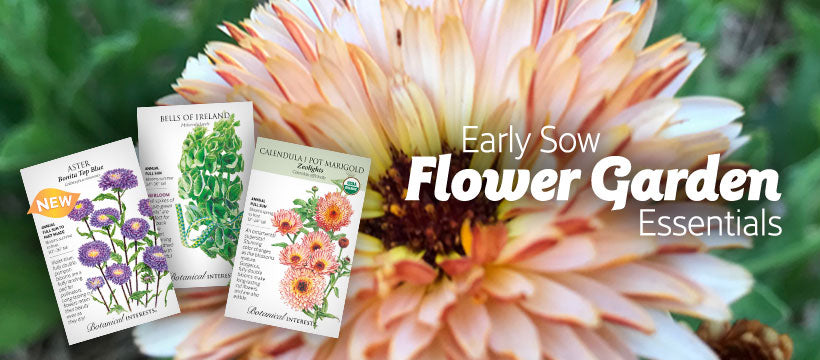Ah yes, summery, sunny, sunflowers—something my garden cannot go without! Sunflowers are great for so many reasons; they attract pollinators, are drought tolerant, make beautiful cut flowers, and originate on the American plains. They also make a great introduction to gardening for children because the seeds are large and easy to handle, quick to germinate, and the iconic flowers are easy to identify.
Sunflowers have been bred for generations, giving us cultivars that produce a single, huge, beautiful head; pollenless varieties for cut flowers; dwarf varieties for containers or just for a shorter option; and blooms in many shades of wonderful.

Single head sunflowers (Mammoth and Sunspot) produce one, large to downright giant (14"!) bloom. Because these sunflowers produce only one big bloom, successively sow once or twice more, every 4 weeks for continual color. If you plan to use these as cut flowers, a tighter spacing of 6" rather than 1' produces longer stems but slightly smaller flowers.
Multi-branching types (Drop Dead Red, Elves Blend, Evening Sun, Florist's Sunny Bouquet, Goldy Honey Bear, Heirloom Beauties, Lemon Queen, Rouge Royale, Shock-O-Lat, Teddy Bear, Vanilla Ice) branch out to display many smaller blooms over a longer period. Give them 1 ½'-2' of space and enjoy their longer bloom period, which is further extended with deadheading or successive sowing.
Pollenless cultivars (Drop Dead Red, Florist's Sunny Bouquet, Rouge Royale) are perfect for table-top arrangements, as they have no messy pollen to dirty your tablecloth. Even without pollen, they still provide plenty of valuable nectar for bees and butterflies. Pollenless sunflowers cannot create seeds on their own, but if you grow them close to pollen-producing types, our winged pollinator friends will ensure seeds form. I like to leave some seed-heavy sunflowers in the garden for the birds who can use some extra energy for fall migration.
Speaking of cut flowers, you'll get the longest vase life out of sunflowers by harvesting them in the morning and choosing flowers that have only a couple of petals that are beginning to lift off the center disk. I love this stage; the flowers look like they are winking at me! Don't forget that a clean vase and frequent water changes are key to the life of any cut flower. More tips for Making Cut Flowers Last Longer.
No matter which sunflower I choose each year, I prefer to wait until a week or two after the average last frost date to direct-sow seeds, since they are sensitive to root disturbance. You can, however, start them indoors in larger (3"-4") biodegradable pots 2 to 4 weeks before your average last frost, as these pots can be planted directly in the ground, minimizing root disturbance. Starting sunflowers indoors does result in earlier blooms, and avoids having vulnerable, tiny seedlings gobbled up by hungry birds. If you direct sow, like I do, pick a sunny spot (6 or more hours of sunshine a day) and protect little sprouts with row cover or another translucent barrier until seedlings are 6" tall, when birds will no longer bother them.
A fun fact about sunflowers is that immature sunflowers turn their heads to follow the sun from east to west each day–a trait called "heliotropism". Once the flowers have fully opened, they stay facing east, protecting the seeds from the harsh afternoon sun. Understanding this alone, can help you plan your sunflower bed so your sunny sunflower faces will open toward a space you can really enjoy them, like the kitchen window or a patio.
Sunflowers are edible, too! The young, unopened flower bud can be steamed and tastes similar to an artichoke, or you can sprinkle the sunny petals on salad or use them to brighten up baked goods.
Whether you use them for cut flowers, sow them to support pollinators, or eat them–sunflowers are truly a joy. I challenge you not to smile back at their sunny faces this summer!
Join in the fun and share your favorite sunflower tips in the comments below.

